July 3rd, 2016
It’s 11:15 am on a lazy Sunday morning as my DART train rattles up the Dublin Coast to Dalkey. Yesterday’s sunshine has disappeared, but the grey skies aren’t raining, and that’s good enough for me.
My only plan for today is to visit the Dalkey Castle & Heritage Center, and the farmer’s market in Dun Laoghaire.
Dalkey is one of the many small towns that dot the Dublin Coast. Back in the 1400s Dalkey was the place for big ships that couldn’t make it into Dublin Harbor to offload their goods. Some goods were immediately placed on wagons bound for Dublin, but some had to be stored in Dalkey. So the merchant families built fortified townhouses to protect their loot, seven or eight in all by the 1700s.
Goat Castle is one of these townhouses, preserved through the years and used as a town hall before being incorporated into the Heritage Center. It was owned by the Cheevers family (from the French word chèvre, which means goat), hence the name Goat Castle.
My first glimpse of Goat Castle is suitably impressive.
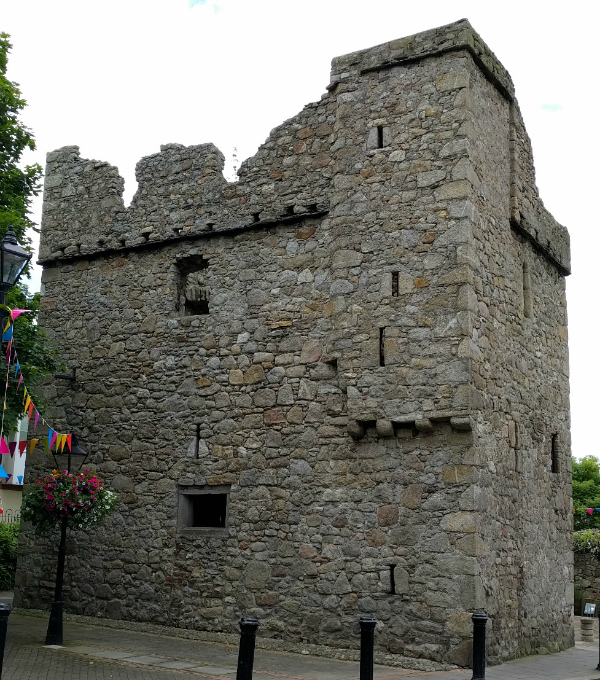
I’ve pre-booked a noon tour, so I’m shown through the Heritage Center and watch a brief video on the history of Dalkey, and Goat Castle in particular. Then we’re shown outside to St. Begnet’s Church
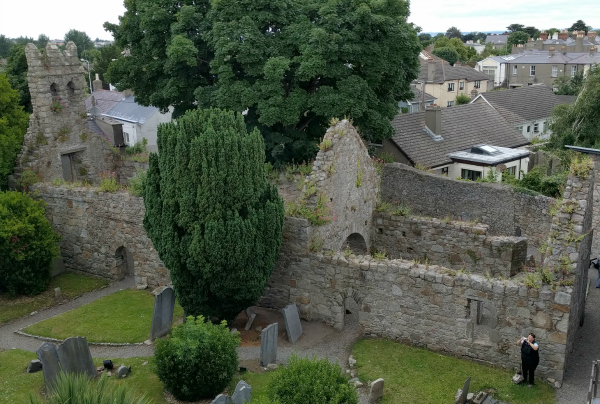
where we’re greeted by the first of our interpretive guides.
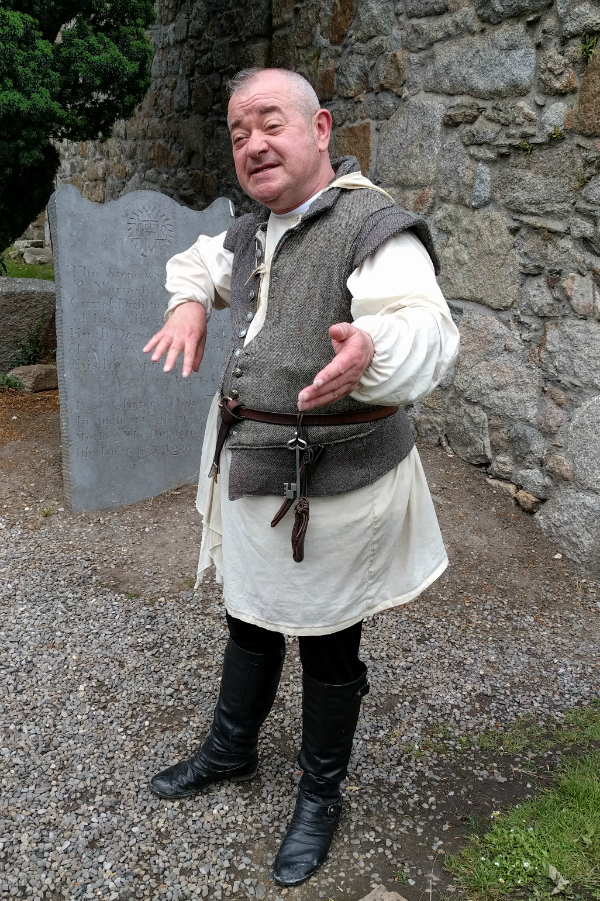
Like the other guides we’re yet to meet, he speaks with just enough pseudo-Middle Ages English phrases to feel authentic, but not so much as to render him unintelligible.
St. Begnet’s was built sometime in the 10th century, and probably replaced a wooden church that was even older. Unusually for an Irish church, it has a twin belfry whose bells were struck by hand. (I would not want to be up on that roof in the rain).
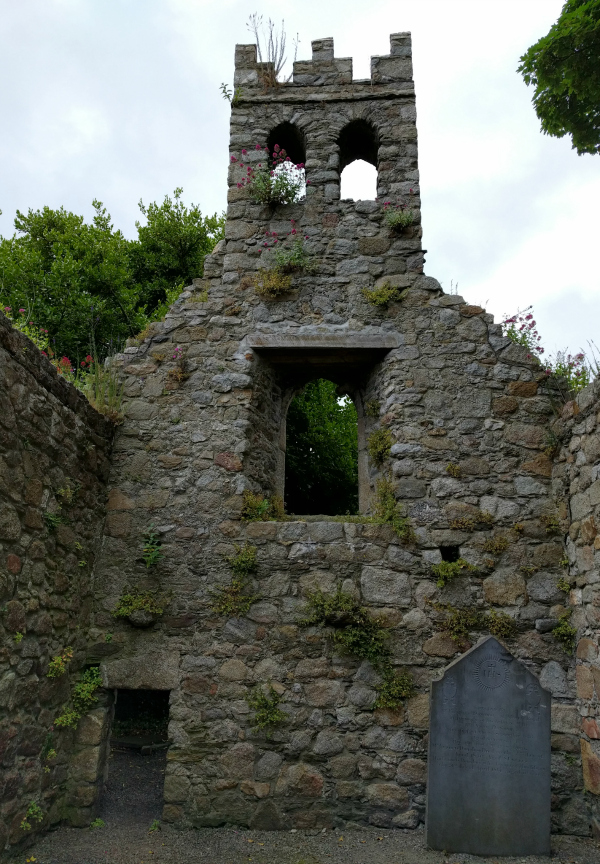
The story of St. Begnet herself is fairly simple. She was born into a good Irish family (some versions even call her an Irish princess). As a child, she was visited by an angel who gave her a bracelet inscribed with a cross. Legend has it that when she was of marriageable age, she decided not to marry but instead ran away with the bracelet and started her life of religious devotion.
The church in Dalkey is dedicated to her, although it’s unclear if St. Begnet was born in Dalkey (as the locals would have you believe) or whether the church was founded by missionaries in her name.
We follow our guide through a very low doorway into the church itself.
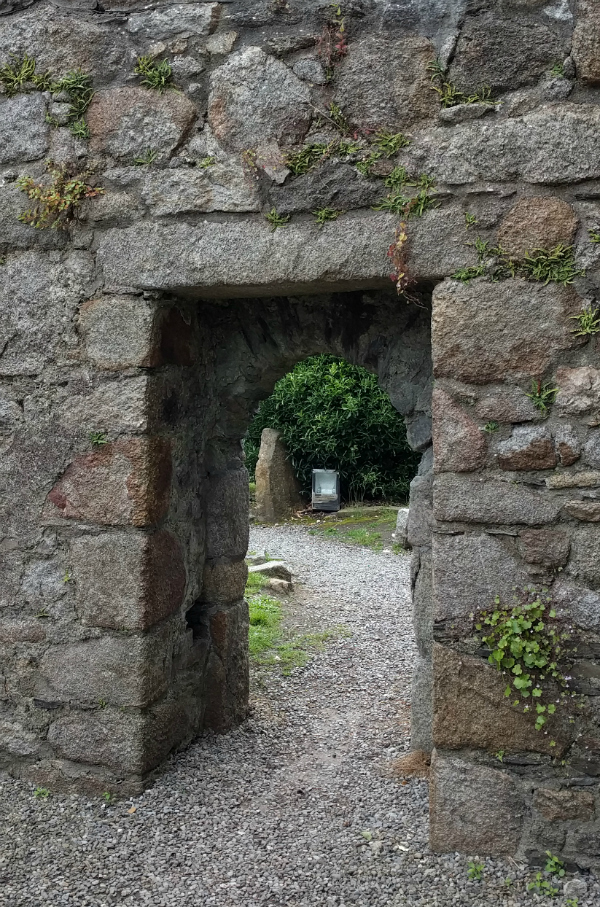
A macabre fun fact: the doorways used to be taller, but over the years so many people were buried in the church that the floor level kept rising as more dirt and gravel were laid down atop the graves.
Inside St. Begnet’s is mostly empty, just a few upright gravestones. The church is in pretty good shape for being abandoned for 400 years.
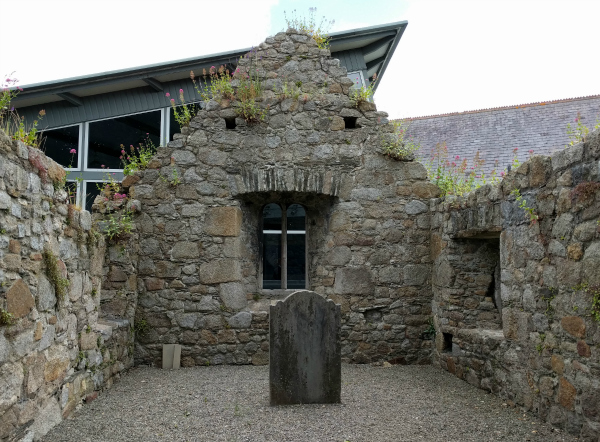
I’m particularly intrigued by the Ambry, which are the niches that were built into the side of the Chancel to hold the bread and wine.
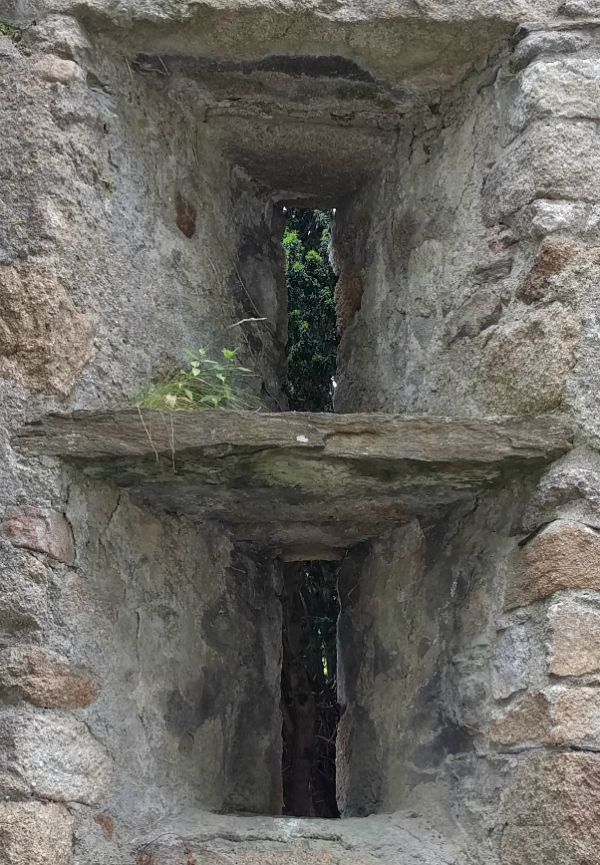
It’s exciting to imagine these niches covered in some way, hiding the treasures within, both from the lay persons and also, perhaps, from marauding Vikings or other Irish clans.
After our tour of St. Begnet’s, we’re taken back into the castle itself and upstairs into the great room. We’re met by the Lord of the Castle, who spends the next several minutes describing the various instruments in a 17th century barber-surgeon’s tool kit.
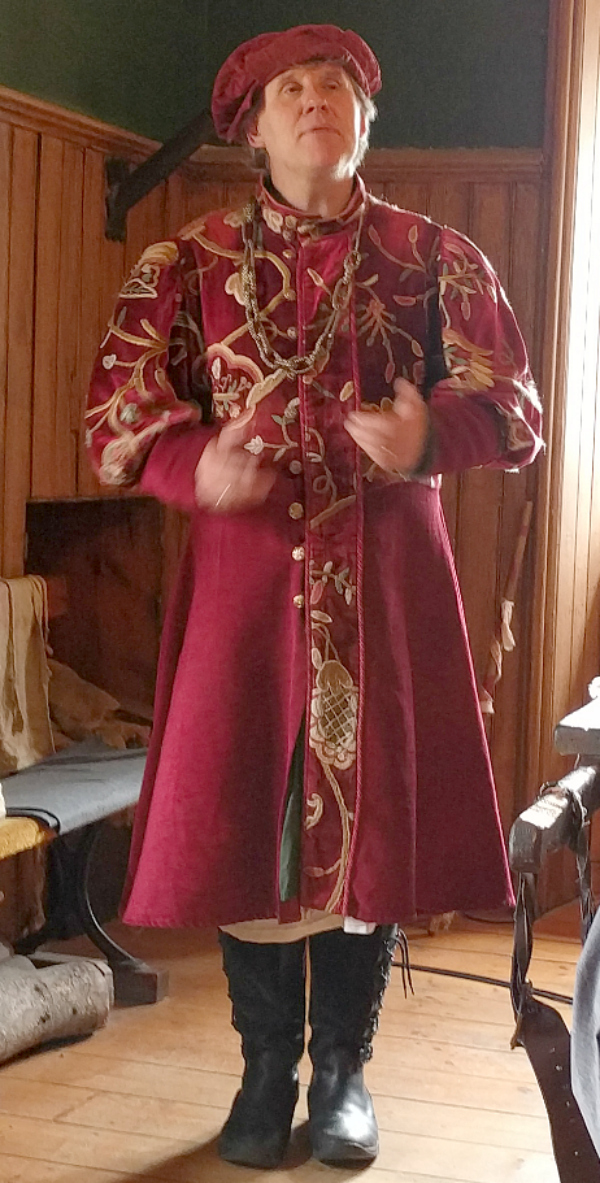
Then we’re handed over to the cook, who shows us the garderobe and brings us up to the roof. Back down in the main room, she describes the various foods she’s making for an upcoming feast.
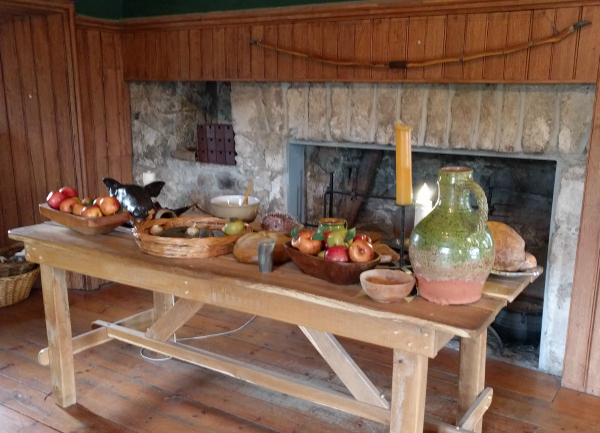
After having visited so many castles, most of the presentations are familiar to me. Both she and the Lord are engaging, though, and bring a sense of life to the townhouse.
The townhouse itself reminds me strongly of Plas Mawr, an Elizabethan townhouse I visited two years ago in Conway, Wales. Plas Mawr is bigger, more elaborate, and not fortified like Goat Castle. But the connection between the two is clear, as if the inspiration for Goat Castle came from a place like Plas Mawr, and was then adapted to local circumstances.
Once the tour is over, I revisit the history displays downstairs in the Heritage Center. I also revisit St. Begnet’s graveyard. It’s much quieter now that it’s empty of tour groups, and the atmosphere of the place sinks into my bones.
By the time I leave Dalkey Castle and Heritage Center, I’ve spent a pleasant couple of hours immersed in medieval history. I debate trying to find the local ferry across to Dalkey Island, just off the coast, but decide to visit the farmer’s market in nearby Dun Laoghaire.
It’s such a lovely overcast day that I walk to the market. My route takes me along several main roads, and I smile as I spot this shop across the street.
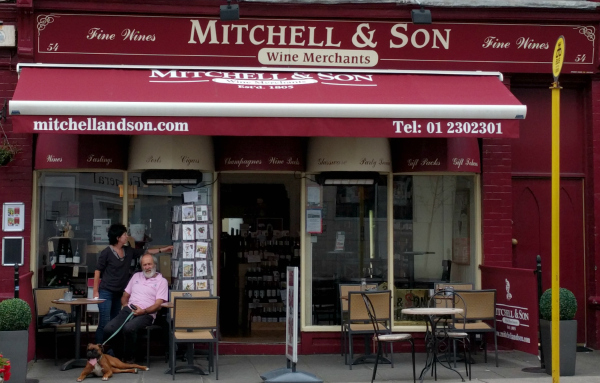
I don’t think I’ve ever seen a real store sign with the words “wine merchant” in it!
Further down the same road, I pass this sign.
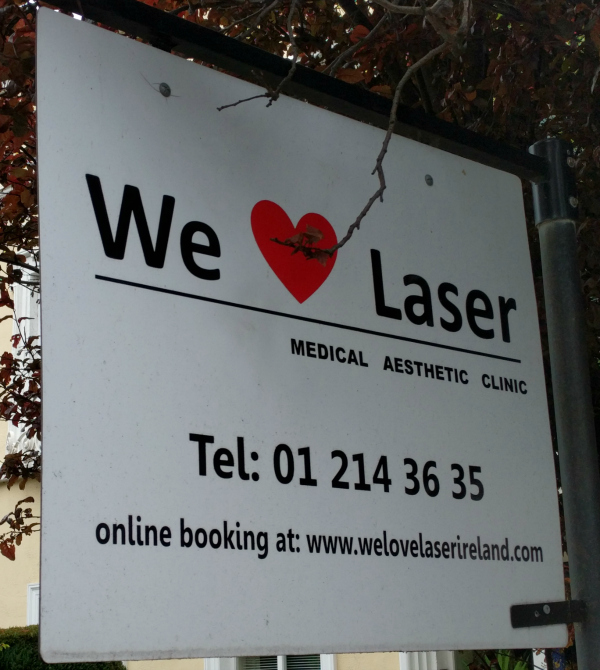
At first glance it’s not very interesting, but take a look at the words underneath “We heart laser.”
I also really like the look of this building, which is at the end of a row of houses.
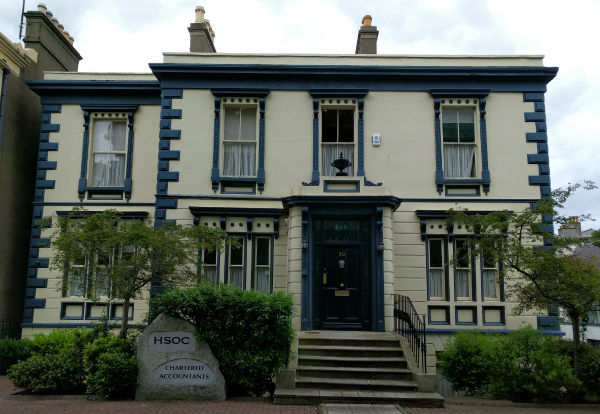
Something about its clean lines, blue quoins, and pale yellow paint makes me think I could live in a place like this.
After about 45 minutes I arrive at the farmer’s market. It’s about two hours before closing, and the place is packed with people and stalls. Live music comes from a bandstand in the middle of the park.
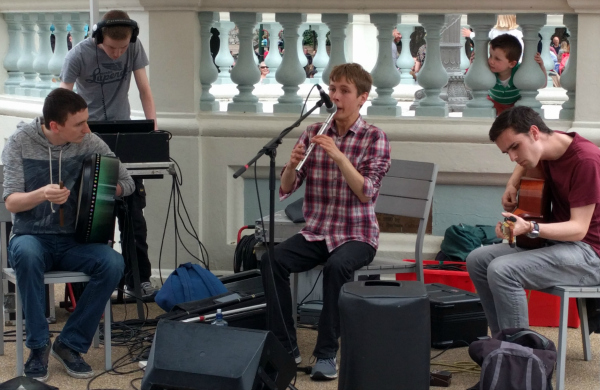
I wander up and down the rows of tents, but nearly all the stalls are cash only, and I have no cash on hand. I do stop to watch as one vendor hand-rolls ice cream on a chilled metal sheet, and to marvel at the long line outside the vendor selling pulled pork sandwiches (the best sandwiches around, according to my hosts).
Exiting the park near the waterfront, Google maps tells me I’m not far away from the Irish National Maritime Museum. Despite being an island nation, I don’t associate Ireland with a strong maritime history. Intrigued, I decide to take a look.
The museum turns out to be an eclectic display of all things maritime. The first surprise is that it’s housed inside Mariners Church, directly behind the great harbor of Dun Laoghaire (by the way, it’s pronounced done-leery. In case you were wondering).
The main floor of the church has dozens of information and display boards. Most of the stories told on these boards are of ships being wrecked off the local coast, or of famous Irish seamen who served on non-Irish ships.
At the front of the church the altar has been replaced by Baily Optic, a 10-tonne revolving lighthouse mirror that (thankfully) has only a dim bulb inside to light it up. Next to it, you can stand in the pulpit and practice sending a message using signal flags to another ship in the back balcony.
The upstairs galleries are even more eclectic. One gallery focuses on Ireland’s earliest navigation, and includes a reproduction of a currach (also called coracles). I’ve read about coracles, but being able to see one close up is a different experience.
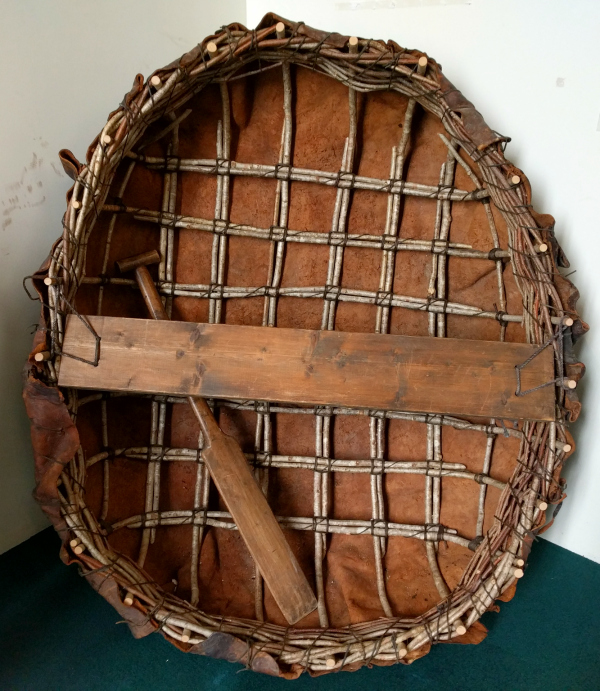
The Irish used boats like these in Neolithic times for fishing and transportation. This one has been made using an animal hide previously on display at the museum, and a frame of hazel. It’s easy to see why they were used for thousands of years – they’re lightweight, versatile, and impervious to leaking.
The other gallery on the opposite side of the church is dedicated to the 1916 Easter Rising. All over the country, I’ve seen signs celebrating this centenary, but this is the first exhibit I’ve seen up close.
The gallery houses a selection of portraits, all painted in rather fantastic colors, like this one of Countess Markievicz:
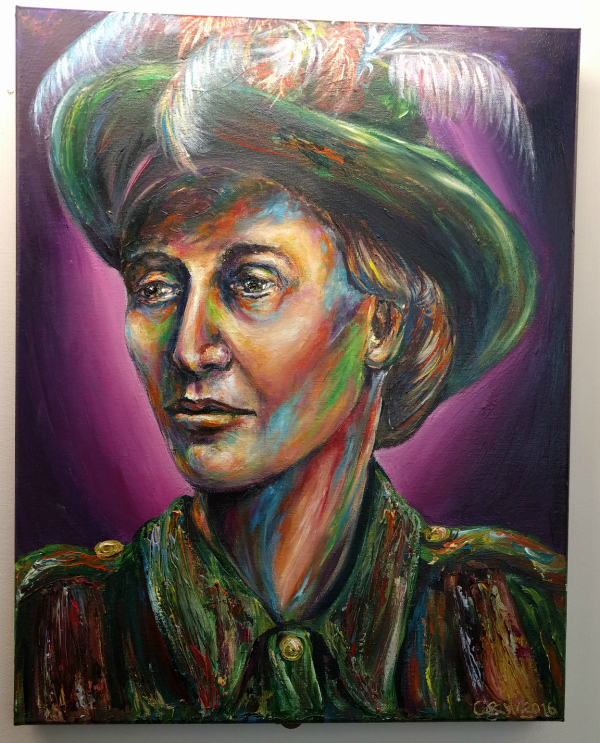
The artist was inspired to create these portraits after reading the works of the Easter Rising leaders just before they were executed.
Each painting has a quote from its subject underneath, and they are all interesting. The one that most captures my attention isn’t attached to any portrait. Instead, it’s a stand-alone piece just before you exit the gallery:
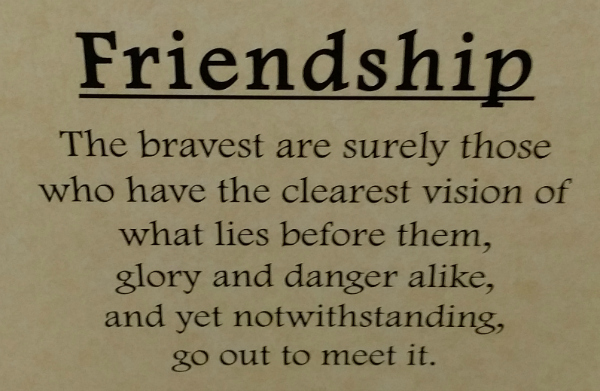
As I exit the Irish National Maritime Museum, I’m naturally drawn to the great harbor of Dun Laoghaire, which is just in front of me. It’s a huge harbor, so big that it’s divided into sections. It’s one of Dublin’s two main ferry ports, although there are none in port at present.
In fact, while researching for this post I learn that before the 1820s, Dun Laoghaire was just some fields and rocky coastline. The pressure was on in Dublin to create a better, more accessible deep water port, and so they built a brand new harbor at Dun Laoghaire. Originally it was called Kingstown, in honor of King George IV who visited the port while it was under construction.
The name was only changed to Dun Laoghaire in 1920 as part of the lead up to Irish independence. It means “fort of Laoghaire” and was named after a 5th century High King of Ireland who used the coastline as a base for his sea raids.
I join the stream of people walking out along the East Pier. The views off the right side to the Irish Sea are spectacular, and the people watching on the left side is hard to beat. With nowhere to be and nothing else on my to-do list for today, I spend a long time walking the upper tier of the pier all the way to the lighthouse at the end.
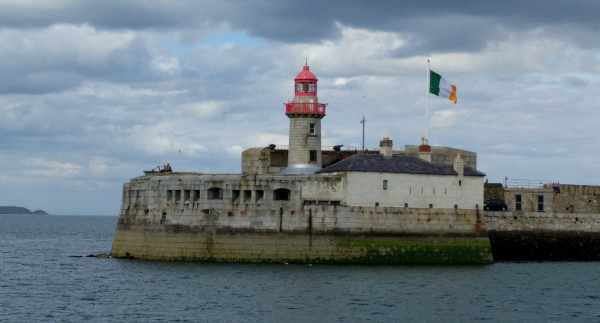
Sitting on the seawall just outside the lighthouse, I see a seal head break the surface of the water. I keep watch for several minutes, and am rewarded with a second sighting a few minutes later. The grey clouds and dark water make seal-spotting difficult, and I lose sight of my seal after the second sighting. Still, I feel lucky – no one else around me seems to have noticed the seal at all.
I take a quick look around the lighthouse, then head back along the pier. Just before I step back onto the mainland, I stop at Dublin Bay Cruises to buy my ticket for an evening sail. After a long day of wandering about, a relaxing sail on the bay sounds like just the thing.
From the moment we cast off at the dock, I know I’ve made the right choice. It’s cool on the top deck, but the sun comes out from time to time and the view of the coastline is glorious.
I strike up a conversation with the older American couple next to me. They tell me that Bono is supposed to have a house somewhere along this coast. We don’t spot Bono’s house, but as we get closer to Dalkey, we see some fabulous houses built on the cliff tops.
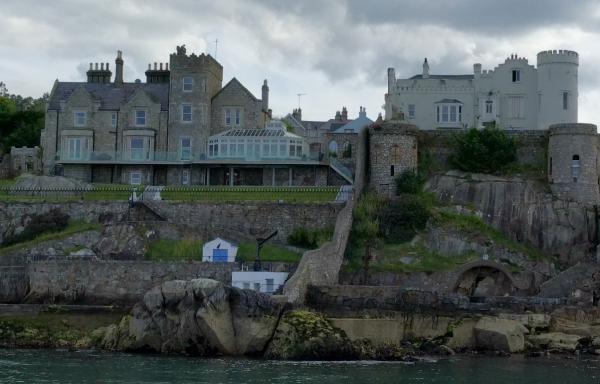
Once past the richy rich houses, the boat turns for a cruise around Dalkey Island. Located just off the coast of Dalkey, the island is uninhabited but is accessible by day ferry. We see several people hiking around the island.
What’s most intriguing are the ruins of church (also dedicated to St. Begnet)
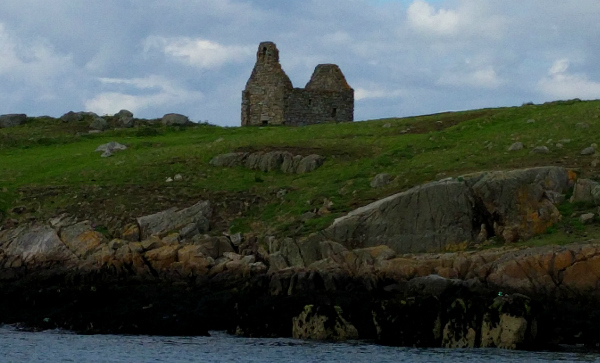
and a Martello tower, built to protect against invasion by Napoleon.
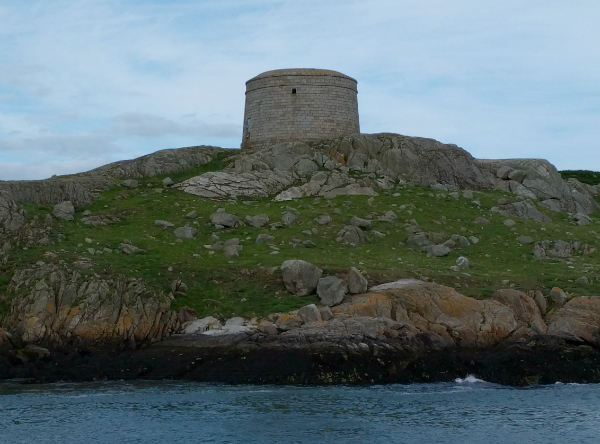
There’s also a fort of some kind at the tip of the island, facing out to sea.
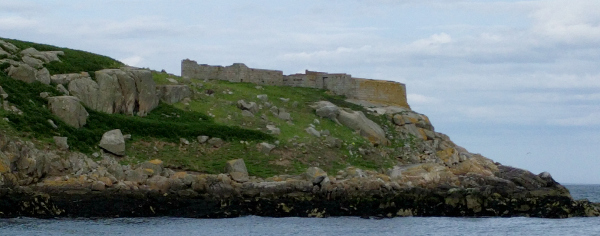
Dalkey Island looks exactly like the sort of deserted, atmospheric place I love. Even from the boat, there’s something mystical about the island.
At last, the boat rounds the seaward side of the island and begins its journey home. Despite the rocking of the boat, I take this gorgeous shot of Dalkey Island with the mainland behind it.

The cruise lasts just over an hour, and it’s a perfect, relaxing way to spend my day. Once on shore, I stop in the local supermarket before catching the DART back to Killiney.
The house is as empty and peaceful when I arrive as it was when I left this morning. Grateful for some alone time, I take my dinner out onto the back patio and watch the sunset.
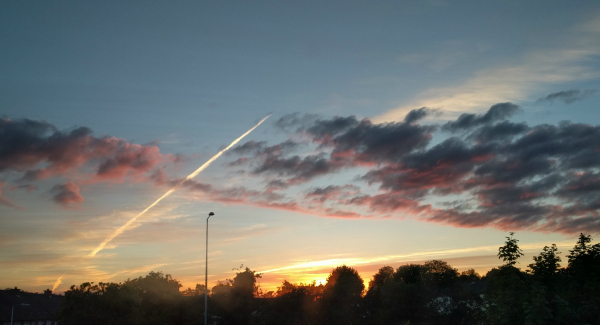
My feet are killing me after a second day of near-continuous walking, but my heart is full and happy. So far this first weekend away from Belturbet has gone perfectly, and there’s still Killruddery House to explore tomorrow before making my way home.
Up next: exploring Killruddery House, home to 16 generations of the Brabazon family and still a working estate!

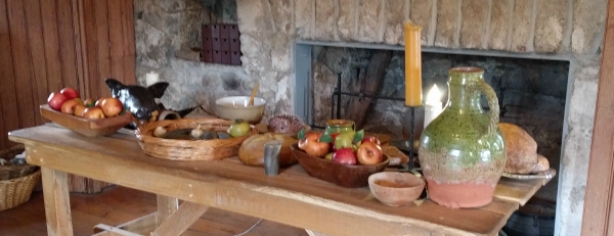









Hiking boots: A good idea if you’re planning on walking over uneven ground through the years. Hard sole, with additional arch & ankle support. Best to save up and purchase quality — if you’re planning on using your feet, knees, and hips in 30 years, best to invest now!
Currachs: Ships, even sailing ships, have been available for over 5000 years — no doubt many arrived in Ireland on the larger vessels. Currachs were easy to build & available — I can imagine several “hill fort clan chiefs” deciding on a long distance “cattle raid”, and using currachs to “sneak up on” the enemy. Just the think to catch the attention of a bard (one of three druidic levels). (They) were very into reincarnation — the better the tales told about them in their current life, the better life they’d be reborn into…
Traveling back to the “Doggerland days” would be interesting — the people & their activities, the wildlife, etc. As ocean levels rose, Northern Europe was steppe rather than forest, and the beginnings of the Ubaid culture in Mesopotamia was making attempts at agriculture, irrigation, and city-building. A diverse world…
I was “taken aback” by the “jack boots” worn by your “church guide” — perhaps he was emulating the ghost of a retired cavalryman…
I wonder what those that live locally think of all the “ruins” — a playground for the kids, etc?
Currach — think of using that small vessel for raids against Wales to the east, or for transporting entire families to & from Scotland. The paddle also looks like a “cricket bat” — a derivation perhaps?
Dalkey Island dates to the Neolithic. Imagine sea levels much lower, and only a long, narrow lake between Ireland and Wales — it would have been the first hill noticed after crossing a much flatter terrain…
(You) need more time on your feet, or a better method of “soaking them” after walking. Maybe an investment in a walking shoe with extra support? Then again, just don’t walk!
You know, I noticed his boots too. But in a “ooh, those are shiny!” sort of way and not in a historical accuracy sense. The heritage center is definitely catering to an audience that isn’t historically aware, and they’ve done a good job of bringing the spirit to the place, if not every detail of authenticity.
St. Begnets is behind a fence and can only be accessed via the heritage center, so I would guess it’s not much visited by locals. Not sure about Dalkey Island and the rest of the ruins – I suppose the locals don’t think much about them except as a place to play.
I could not imagine getting into a currach on the Irish Sea. It’s incredible to think of what our ancestors did with so little technology and just a sense that a job had to be done with the tools at hand. There was no signage about the linkage between the paddle and a cricket bat, but I am sure if you dig around in history far enough, there’s a connection. Most things are connected if you dig deep enough, right?
I would like a time travel machine simply to see what the British Isles looked like in Neolithic times, before the sea rose. I mean, it’s one thing to know/imagine that England and France were all connected, but to actually see it . . . that would be something.
As for my feet, I think the problem is that the shoes I’ve got were designed to walk long distances on flat, mostly even surfaces. I can walk around a city all day in them and only feel slightly sore, but take them off onto something like the Cliff Walk, with gravel underfoot, and man do they not hold up well.
I’d take a broomstick or a hovercar, but since no one’s invented either in my price range, I guess I’ll stick to walking. 🙂